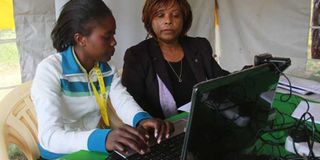Civil servants who missed biometric registration struck off payroll

A civil servant goes through biometric registration in Nyeri on September 24, 2014. Over 12,500 names of government employees who failed to show up for the biometric registration will be removed from the payroll beginning November 2014. PHOTO | JOSEPH KANYI | NATION MEDIA GROUP
What you need to know:
- The government payroll stands at 172,522 employees but only 160,012 people turned up for the drive.
- If it turns out that those who failed to register were ghost workers, then the government has been losing Sh600 million per month in paying salaries and allowances.
- This also means that taxpayers have been losing up to Sh7.2 billion a year, a factor that has contributed to the ballooning wage bill.
- The figure is higher than the Sh1.8 billion per year that President Uhuru Kenyatta said the government was losing when he launched an audit to weed out the ghost workers.
Over 12,500 names of government employees will be struck off the payroll beginning November after they failed to show up for the biometric registration.
The government payroll stands at 172,522 employees, but according to Devolution and Planning Cabinet Secretary Anne Waiguru, only 160,012 people turned up for the drive.
Consequently, if it turns out that those who failed to register were ghost workers, then the government has been losing Sh600 million per month in paying salaries and allowances.
This also means that taxpayers have been losing up to Sh7.2 billion a year, a factor that has contributed to the ballooning wage bill.
The figure is higher than the Sh1.8 billion per year that President Uhuru Kenyatta said the government was losing when he launched an audit to weed out the ghost workers at the beginning of the year.
While presenting preliminary findings of a report on the Capacity Assessment and Rationalisation of the Public Service (CARPS) programme carried out by the Inter-Governmental Steering Committee (IGSC), which she chairs, Ms Waiguru said workers who could not take part in the registration due to sickness or study leave were not included in the list of 12,510 missing persons.
STOP SALARIES
“In the wake of these developments, the steering committee has directed that both the national and county governments stop with immediate effect the salaries of the 12,510 who have failed to show up,” she said.
The report also revealed that about 300 officers were older than the official retirement age of 60.
Public Service Commission (PSC) Chairperson Margaret Kobia said the next step would be to establish who was responsible for the inclusion of the additional names so that proper legal action may be taken.
“We cannot ignore the possibility that some names may have been duplicated due to inter-departmental transfers and the devolution process.
“The complexity makes it necessary for the PSC to find out who should be held responsible,” she said.
She cited officers in the human resources departments as well as those manning payrolls in both levels of government as targets for the investigations.
“Those civil servants who allowed ghost workers to receive payment will be held accountable,” Prof Kobia said.
Nation.co.ke learnt that those involved in the networks may have been substituting names of dead or retired employees with those of their cronies, who received the money.
OUTDATED IT SYSTEM
They take advantage of the outdated IT system that has not kept pace with developments in modern finance to ensure theft of public money goes undetected.
However, Prof Kobia exuded confidence that with the modern ICT tools put in the payroll system, it will be impossible for anyone to sneak in ghost workers.
“The technology acquired by the government is very modern and with the details of all civil servants now captured in the biometric data, cases of ghost workers will now become a impossible,” she said.
Also attending the launch of the report at Harambee House in Nairobi was Transition Authority Chairman Kinuthia Wamwangi, Salaries and Remuneration Commission (SRC) Chairperson Sarah Serem and Council of Governors's Human Resource and Social Welfare committee chairman James Ongwae.
Mr Ongwae said the analysis of the findings of the report will take longer than expected and that a conclusive report will be released in February 2015.
Ms Waiguru explained that some employees had different dates of birth in different documents and the rationalisation of these documents had made it necessary to extend the exercise.
On September 1, 2014, President Kenyatta launched the biometric registration drive targeting civil servants at both the national and county government levels.
Nairobi Governor Evans Kidero also launched the exercise for Nairobi County on the same day, followed by other counties on September 22 and October 13.
The exercise, which ended on October 31, 2014, was carried out by the Inter-Agency Technical Committee (IATC) with the support of both the national and county governments.





